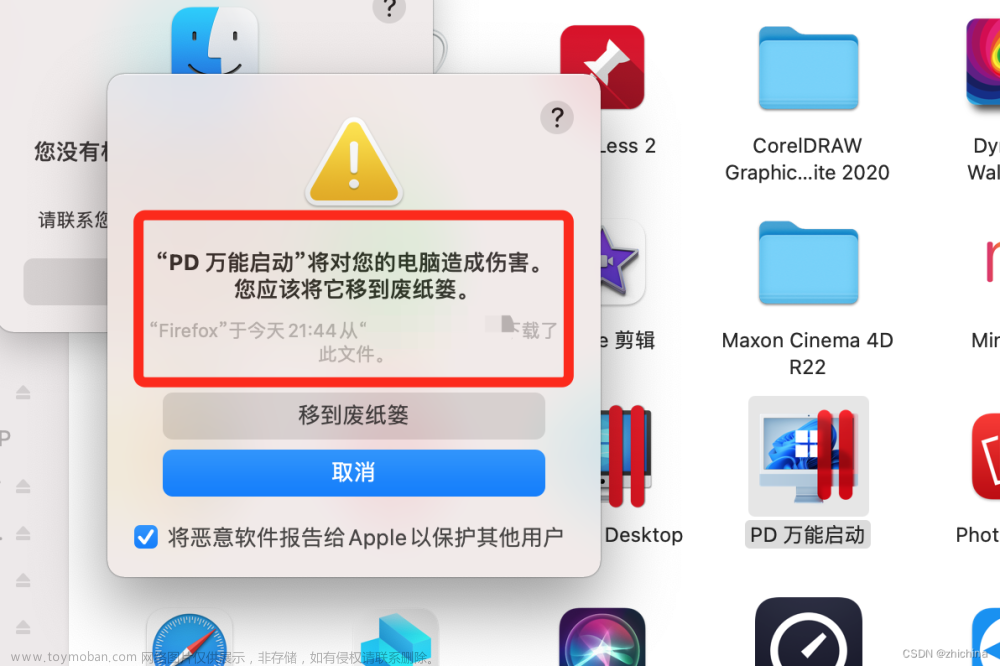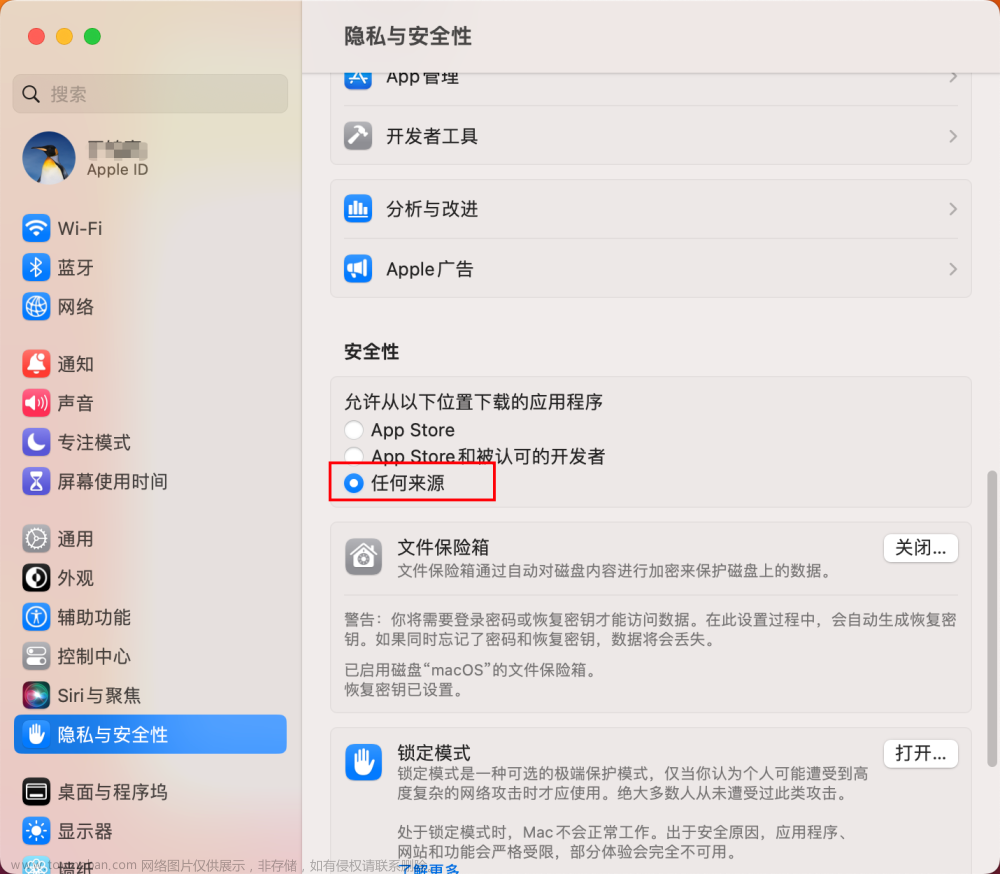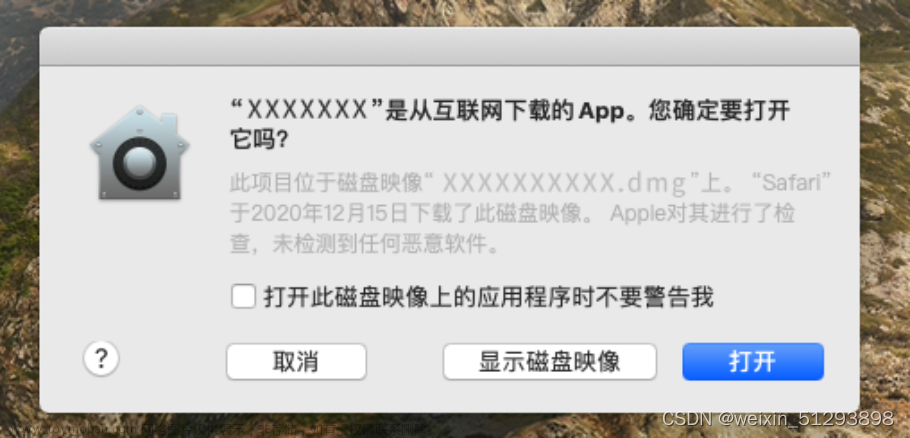
文件损坏?尊嘟假嘟?
第一步:允许打开任何来源软件

sudo spctl --master-disable 文章来源:https://www.toymoban.com/news/detail-778307.html
文章来源:https://www.toymoban.com/news/detail-778307.html

第二步:解除 GateKeeper 安全机制
xattr -cr


关于 com.apple.quarantine
com.apple.quarantine—Tagging files downloaded from the Internet as possibly untrustworthy, storing the application used to download them, among other things.
补充知识:扩展文件属性
在类 Unix系统中,扩展属性通常缩写为xattr。
Man xattr 可查看命令手册
Last login: Fri Feb 24 21:19:49 on ttys000
➜ ~ xattr /Applications/iTerm.app
com.apple.quarantine
➜ ~ xattr -l /Applications/iTerm.app
com.apple.quarantine: 01c1;63f0c653;Homebrew\x20Cask;0D2B9537-08B4-4AC7-ABD1-8D6E3BFA078C
➜ ~ clear
XATTR(1) General Commands Manual XATTR(1)
NAME
xattr – display and manipulate extended attributes
SYNOPSIS
xattr [-lrsvx] file ...
xattr -p [-lrsvx] attr_name file ...
xattr -w [-rsx] attr_name attr_value file ...
xattr -d [-rsv] attr_name file ...
xattr -c [-rsv] file ...
xattr -h | --help
DESCRIPTION
The xattr command can be used to display, modify or remove the extended
attributes of one or more files, including directories and symbolic links.
Extended attributes are arbitrary metadata stored with a file, but separate
from the filesystem attributes (such as modification time or file size).
The metadata is often a null-terminated UTF-8 string, but can also be
arbitrary binary data.
One or more files may be specified on the command line. For the first two
forms of the command, when there are more than one file, the file name is
displayed along with the actual results. When only one file is specified,
the display of the file name is usually suppressed (unless the -v option
described below, is also specified).
In the first form of the command (without any other mode option specified),
the names of all extended attributes are listed. Attribute names can also
be displayed using “ls -l@”.
In the second form, using the -p option (“print”), the value associated
with the given attribute name is displayed. Attribute values are usually
displayed as strings. However, if nils are detected in the data, the value
is displayed in a hexadecimal representation.
The third form, with the -w option (“write”), causes the given attribute
name to be assigned the given value.
The fourth form, with the -d option (“delete”), causes the given attribute
name (and associated value), to be removed.
In the fifth form, with the -c option (“clear”), causes all attributes
(including their associated values), to be removed.
Finally, the last form, with either the -h or --help option, displays a
short help message and exits immediately.
OPTIONS
-l By default, the first two command forms either displays just the
attribute names or values, respectively. The -l option causes both the
attribute names and corresponding values to be displayed. For
hexadecimal display of values, the output is preceeded with the
hexadecimal offset values and followed by ASCII display, enclosed by
“|”.
-r If a file argument is a directory, act as if the entire contents of the
directory recursively were also specified (so that every file in the
directory tree is acted upon).
-s If a file argument is a symbolic link, act on the symbolic link itself,
rather than the file that the symbolic link points at.
-v Force the file name to be displayed, even for a single file.
-x Force the attribute value to be displayed in the hexadecimal
representation.
The -w option normally assumes the input attribute value is a string.
Specifying the -x option causes xattr to expect the input in
hexadecimal (whitespace is ignored). The xxd(1) command can be used to
create hexadecimal representations from exising binary data, to pass to
xattr.
EXIT STATUS
The xattr command exits with zero status on success. On error, non-zero is
returned, and an error message is printed to the standard error. For
system call errors, both the error code and error string are printed (see
getxattr(2), listxattr(2), removexattr(2) and setxattr(2) for a complete
list of possible error codes).
Some attribute data may have a fixed length that is enforced by the system.
For example,
% xattr -w com.apple.FinderInfo 0 foo
xattr: [Errno 34] Result too large: 'foo'
The com.apple.FinderInfo attribute must be 32 bytes in length.
EXAMPLES
This example copies the com.apple.FinderInfo attribute from the /usr
directory to the MyDir directory:
% xattr -px com.apple.FinderInfo /usr
00 00 00 00 00 00 00 00 40 00 00 00 00 00 00 00
00 00 00 00 00 00 00 00 00 00 00 00 00 00 00 00
% xattr -l MyDir
% xattr -wx com.apple.FinderInfo \
"`xattr -px com.apple.FinderInfo /usr`" MyDir
% xattr -l MyDir
com.apple.FinderInfo:
00000000 00 00 00 00 00 00 00 00 40 00 00 00 00 00 00 00 |........@
.......|
00000010 00 00 00 00 00 00 00 00 00 00 00 00 00 00 00 00 |.........
.......|
00000020
SEE ALSO
ls(1), xxd(1), getxattr(2), listxattr(2), removexattr(2), setxattr(2)
macOS 12.6 November 29, 2010 macOS 12.6
(END)命令行选项文章来源地址https://www.toymoban.com/news/detail-778307.html
参考文档:
到了这里,关于Mac软件打开提示:已损坏,无法打开。您应该将它移到废纸娄 怎么解决?的文章就介绍完了。如果您还想了解更多内容,请在右上角搜索TOY模板网以前的文章或继续浏览下面的相关文章,希望大家以后多多支持TOY模板网!












